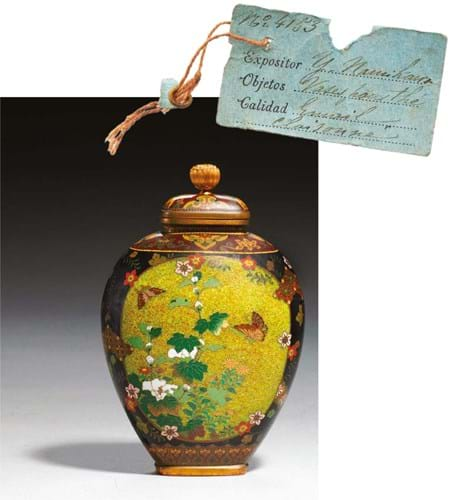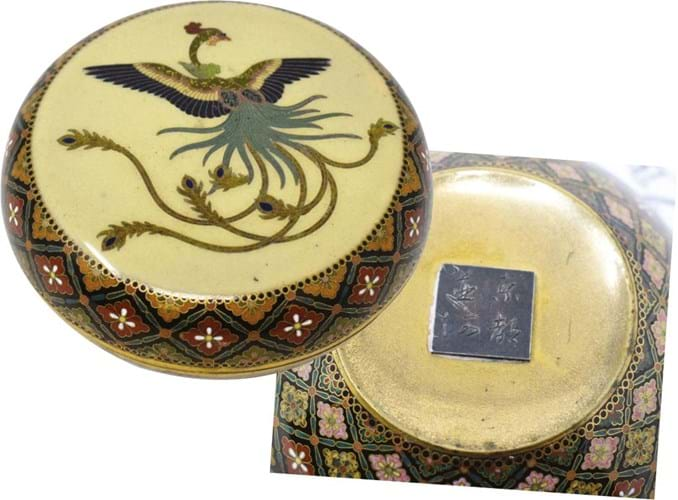A Meiji period vase by one of the great exponents of the intricate art of cloisonné enamel will be heading back to Japan after its sale at The Canterbury Auction Galleries (24% buyer’s premium inc VAT).
The 7in (18cm) vase from the Kyoto workshop of Namikawa Yasuyuki (1845-1927) was decorated in coloured enamels and varying thicknesses of gold wire with a cockerel and a Pekin chicken among flowers and birds. Signed to the base, it sold to a Japanese collector bidding online via thesaleroom.com for £29,000 on April 10.
The vase, estimated at £4000-6000, had been acquired at some time in the late 19th or early 20th century by Edward John Power (1858-1916), a collector of Oriental items, and it had passed by descent to his great-grandson.
“It was a piece of exhibition quality,” said auctioneer Cliona Kilroy. “We chose it to illustrate the back cover of the sale catalogue and we knew it would sell well, but I was surprised it fetched so much.”
Namikawa was instrumental in refining the Chinese art of cloisonné into the elegant visual fantasies known in Japan as shippo-yaki.
By the 1890s, he employed a team of highly skilled specialist craftsmen in Kyoto fulfilling imperial commissions and selling to private Edwardian collectors of Japanese art worldwide.
A major exhibition in Japan in 2017 reignited interest in his work.
Phoenix rises
Two other pieces by Namikawa have appeared on the UK regional market in recent weeks – one of them hiding behind the ignominy of a £70-100 estimate. This was the small 3in (7.5cm) box and cover decorated with a phoenix, and full signature to the base, that appeared at Charterhouse (22% buyer’s premium) in Sherborne, Dorset on April 17.
The auction house received a deluge of interest before the sale prompting them to add the epithet ‘in the style of Namikawa Yasuyuki’ to the online catalogue description. Despite some small areas of damage inside the lid, it sold accordingly at £11,000.
Mark of quality
Namikawa believed that “if my work will not declare itself to be mine, then the marking will do no good”.
Not all work from the studio was signed. An unsigned 6in (15cm) high vase and cover offered at Mellors & Kirk (20% buyer’s premium) of Nottingham on March 20 was an autograph work decorated with panels of flowers and butterflies or a phoenix separated by silver and copper wires.

An unsigned vase and cover – £16,000 at Mellors & Kirk. The exhibition label above was found inside.
It was sold together with a blue card label, found inside, for the Barcelona Universal Exposition, 1888. Enamels by the Namikawa workshop were displayed in the Japanese pavilion at Barcelona alongside work by Kozan, Eisuke and Chokichi, together with a large display of the work of prestigious Japanese companies co-ordinated by Matsuo Gisuke (1837-1932).
The subject of much interest before the sale, it eventually sold to a phone bidder at £16,000.
Namban from Kyoto
Kyoto ‘export’ art from a much earlier period was offered at Bearnes Hampton & Littlewood (21% buyer’s premium) in Exeter on April 16.
The portable cabinet decorated in gold hiramaki-e and shell was typical of the ‘Namban’ wares produced in the Kyoto’s lacquer workshops for Asian and European markets.
A glimpse of the splendours of the late 16th or early 17th century Momoyama age, it was these exotic wares that ensured that the word ‘Japan’ would be synonymous with ‘lacquer’ in the following centuries.
This example, measuring 15in (38cm) across, features floral panels to both the sides and the three interior drawers contracted by squares of shagreen.
It had some losses but was on the market with an estimate of just £2000-3000. It sold via thesaleroom.com at £19,500.
















